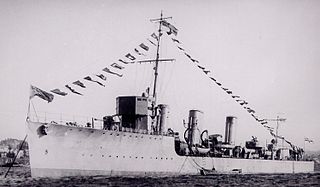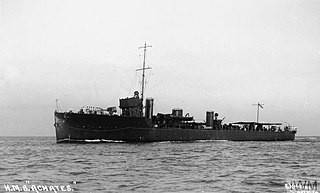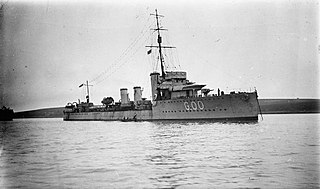
HMS Ithuriel was a Marksman-class flotilla leader of the British Royal Navy. Originally to have been named Gabriel, the name was changed before her launch. The ship was built by Cammell Laird at Birkenhead, being launched on 8 March 1916 and entering service in August that year. Ithuriel served with the Grand Fleet during the First World War, leading both a destroyer flotilla and a submarine flotilla. She survived the war, before being sold for scrap on 8 November 1921.
HMS Owl was an Acasta-class destroyer of the Royal Navy, launched in 1913. The destroyer was part of the Grand Fleet during the First World War and took part in the Battle of Jutland. Owl survived the war and was sold for scrap in 1921.

HMS Porpoise was an Acasta-class destroyer of the Royal Navy, which was built by Thornycroft between 1912 and 1914. Porpoise served through the First World War, taking part at the Battle of Jutland in 1916, where she was damaged. In 1920, she was sold to the Brazilian Navy serving under the name Alexandrino de Alencar and was renamed Maranhão in 1927. Maranhão remained in service when Brazil entered the Second World War, being used for patrol and convoy duties. She was disposed of in 1945.
HMS Laverock was a Laforey-class destroyer of the Royal Navy. She was launched in 1913 and entered service in October 1914. Laverock served through the First World War, operating with the Harwich Force and in the English Channel. She was sold for scrap in 1921.

HMS Nimrod was a Marksman-class flotilla leader of the British Royal Navy. She was built by the Scottish shipbuilder Denny, with construction starting in 1914 and completed in August 1915. She served through the remainder of the First World War. She was sold for scrap in 1921.
HMS Lightfoot was a Marksman-class flotilla leader of the British Royal Navy. Construction by J. Samuel White began in June 1914, shortly before the outbreak of the First World War, and the ship was launched and completed in 1915. She survived the war and was sold for scrap in 1921.

HMS Rob Roy was a Royal Navy R-class destroyer constructed and then operational in the First World War. The ship served in the Grand Fleet as part of the Fifteenth Destroyer Flotilla.
HMS Christopher was an Acasta-class destroyer of the British Royal Navy. She was built by Hawthorn Leslie in 1911–1912. She served throughout the First World War, forming part of the Grand Fleet until 1916 and taking part in the Battle of Jutland. Later in the war she served in the English Channel to protect merchant shipping against attacks by German U-boats. Christopher was sold for scrap in May 1921.

HMS Landrail was a Laforey-class destroyer of the British Royal Navy. The Laforey class was the class of destroyers ordered under the Royal Navy's 1912–1913 construction programme, which were armed with three 4-inch (102 mm) guns and four torpedo tubes and were capable of 29 knots. The ship, which was originally to be named Hotspur but was renamed before launch, was built by the Scottish shipbuilder Yarrow between 1912 and 1914,
HMS Lark was a Laforey-class destroyer of the British Royal Navy. The Laforey class was the class of destroyers ordered under the Royal Navy's 1912–1913 construction programme, which were armed with three 4-inch (102 mm) guns and four torpedo tubes and were capable of 29 knots. The ship, which was originally to be named Haughty but was renamed before launch, was built by the Scottish shipbuilder Yarrow between 1912 and 1913.

HMS Rapid was a destroyer of the M class which served with the Royal Navy. Launched by Thornycroft on 15 July 1916 as the first of six similar ships, the destroyer served as part of the Grand Fleet during World War I. The design was used as the basis for the subsequent five ships of the R-class also built by the yard. Rapid served in escort and patrol roles, principally providing defence from submarines as part of the Grand Fleet until it was disbanded at the end of the War. After the end of hostilities, the vessel served in minor roles, including briefly as part of the Admiralty Compass Department, but was sold to be scrapped on 20 April 1927.

HMS Achates was an Acasta -class destroyer of the British Royal Navy. She was built by the Scottish shipbuilder John Brown and was built between 1912 and 1913. Like all Acasta-class destroyers, Achates was armed with three 4-inch (102 mm) guns and two torpedo tubes, with a specified speed of 29 knots.

HMS Alarm was a Acorn-class destroyer of the British Royal Navy. She was built by John Brown and Company at their Clydebank shipyard, being built between 1910 and 1911, completing in March 1911. Alarm had oil-fuelled steam turbine machinery that was designed to give a speed of 27 knots. Armament consisted of two 4-inch guns, two 12-pounder guns and two 21-inch torpedo tubes.
HMS Gabriel was a Marksman-class flotilla leader of the British Royal Navy, that took part in the First World War. The ship was built by Cammell Laird at Birkenhead, being launched on 23 December 1915 and entering service in July 1916. Gabriel served with the Grand Fleet, leading a destroyer flotilla and was later used as a minelayer. She survived the war, before being sold for scrap on in May 1921.
HMS Grenville was a Parker-class flotilla leader of the British Royal Navy. She was built by Cammell Laird during the First World War, being launched on 17 June 1916 and completing on 11 October that year. Grenville served with the Grand Fleet for the rest of the war, which she survived. The ship took part in operations in the Baltic during the Russian Civil War in the winter of 1919–1920, before entering a long period of reserve. She was sold for scrap in December 1931.
HMS Parker was a Parker-class flotilla leader of the British Royal Navy, and the lead ship of her class. She was built by Cammell Laird during the First World War, being launched on 16 August 1916 and completing on 13 December that year. Parker served with the Grand Fleet for the rest of the war, which she survived. The ship was sold for scrap in November 1921.

HMS Seymour was a Parker-class flotilla leader of the British Royal Navy. She was built by Cammell Laird during the First World War, being launched on 31 August 1916 and completing on 30 November that year. Seymour served with the Grand Fleet for the rest of the war, which she survived. The ship was sold for scrap in January 1931.

HMS Rocket was an R-class destroyer which served with the Royal Navy during World War I. Launched on 2 July 1916 after being stuck on the slipway since 30 June, the ship joined the Grand Fleet, operating as part of a destroyer flotilla undertaking anti-submarine operations in the North Sea. Although the ship did not successfully engage any German submarines, there was an incident with the Royal Navy boat K7 on 16 June 1917, although that attack was aborted after the erstwhile target was identified as a friendly vessel. After the War, the destroyer served with the anti-submarine and torpedo schools at Portsmouth, and briefly during the Chanak Crisis of 1922, before being sold to be broken up on 16 December 1926.

HMS Lawford was a Laforey-class destroyer of the British Royal Navy. The Laforey class was the class of destroyers ordered under the Royal Navy's 1912–1913 construction programme, which were armed with three 4-inch (102 mm) guns and four torpedo tubes and were capable of 29 knots. The ship, which was originally to be named Ivanhoe but was renamed before launch, was built by the Scottish shipbuilder Fairfields between 1912 and 1914.

HMS Plucky was an Admiralty M-class destroyer which served with the Royal Navy during the First World War. The M class were an improvement on the previous L-class, capable of higher speed. Launched on 21 April 1916 by Scotts of Greenock, the vessel served as part of the Grand Fleet, spending most of the war based out of Plymouth, apart from a brief sojourn working from the Irish port of Buncrana. Plucky was mainly involved in anti-submarine warfare and escorting the merchant ships that made up the convoys travelling to and from England, colliding with one, the collier Mervin in February 1917. Fortunately the merchant vessel was unharmed, but the subsequent explosion but the destroyer temporarily out of action. After armistice, the destroyer was redeployed to Portsmouth until being decommissioned and sold to be broken up on 9 May 1921.











